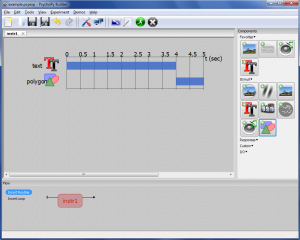
- #End routine after number of keypresses psychopy builder movie
- #End routine after number of keypresses psychopy builder manual
Importantly, one common thing in working with keypresses is that you want to check whether a particular key was pressed. TDown: a float with the abolute time (in seconds unlikely you ever need this) ĭuration: a float with the time (in seconds) the key was pressed in (or None if still pressed in) Rt: a float with the time (in seconds) from start of the Keyboard clock (i.e., the clock attribute) Name: a string with the name of the pressed key (e.g., "a", "b", "return", "left", etc.) In fact, these KeyPress objects contain much more information that is contained in its attributes: Then, run the experiment and check the Experiment runner to see the printed output.Īs you can see, the getKeys method specifically returns a list of KeyPress objects! These objects are not just strings corresponding to the pressed keys (e.g., “a”, “b”, “return”, “left”, etc.), as you might expect.
#End routine after number of keypresses psychopy builder manual
Check out PsychoPy’s reference manual for a complete overview of the package’s modules.Īs you will see, most of PsychoPy’s functionality (like the different components) is implemented in custom classes, so your experience with object-oriented programming as discussed in week 1 will be very useful!Īfter the initialization of the Keyboard object and the call to wait (from the previous ToDo), call the getKeys function and store the result in a variable (e.g., keys) and print this variable.
#End routine after number of keypresses psychopy builder movie
For example, the visual module contains a class to specify and create a window and a large set of visual components (like text, image, and movie components) and the event module contains code to work with “events” such as mouse clicks/movement and keyboard presses. The psychopy package contains different modules for different features. However, as mentioned on the Getting started page, getting the psychopy package to work is not easy, which is why we recommend the “batteries included” standalone version of PsychoPy. Thank you.If you plan on programming your PsychoPy experiment (so not use the Builder interface), you technically do not need the entire “standalone” PsychoPy package installing the psychopy Python package would suffice and you could just write your experiments in your favorite editor (like Visual Studio Code). I have tried both "trials.finished = True" and "continueRoutine = False " but in both cases Routine2 is not skipped. > Is that possible from the builder? I think it should be but somehow I am missing something here. But as of now when I have set "trials.finished = True" in Routine 1 code component, the loop does end but it ends up executing Routine 2 which I want to skip. > But when it is terminated, I want that Routine 2 should not be run. Based on the condition in the code component, I terminate the loop. > I have two routines in a loop and Routine 1 is a code component. in another code component in Routine 2, you could put something like this in its "begin routine" tab so that Routine 2 never even starts if you have set the loop to end in the previous routine:

In your case, you will want to set "trials.finished = True" so that the loop won't run again, but you will also need to set "continueRoutine = False" in *every other* routine within that loop.Į.g. So if in Routine 1, you do both of the above, the net effect is that Routine 1 will end immediately, but Routine 2 will run once, and only then will the loop terminate, before Routine 1 runs again. Is checked on every screen refresh and so will terminate the current routine almost immediately. Will have any effect until the end of the current loop iteration, whereas


 0 kommentar(er)
0 kommentar(er)
